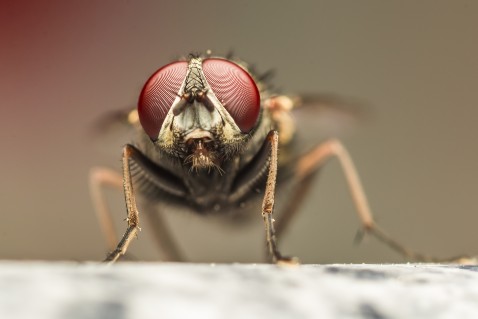How Flies Transmit Disease in Food Production
By Aaron Soudant
They pollinate plants, kill spiders and hunt dragonflies. But they also consume decomposing bodies and eat the sludge in drainage pipes. They are loaded with bacteria and spread diseases that are harmful to humans.
One of the most problematic insects for food producers are flies. They carry pathogens and bacteria, contaminate food and multiply quickly. While there are thousands of fly species, some of the most common include small flies (fruit fly and drain fly) and large flies (house fly, cluster fly, and blowfly).

With mouthparts designed for piercing, sucking or sponging, much of the problem is what they feast on — decaying organic matter. You may not think much of these winged insects that can drop onto the side of your plate, but if that fly could talk and tell you of the journey it took, you might go running for the hills.
Let’s start at the beginning.
The basic life cycle of a fly begins with a female laying an egg. The reproductive capacity of a female fly is enormous. Depending on the species of fly, she can lay up to a few thousand eggs during her lifetime. Flies can lay their eggs in garbage cans, compost piles, excrement and/or decaying organic matter. The egg then develops through a larva phase, a pupa phase, and finally, into an adult. All this while the growing fly continues to feed on the very garbage or decaying matter it was hatched in.
And, while they double in size, molt, double in size and molt again, not only do they eat the stuff, but they get covered in it as well. During a warm summer — their life cycle, from egg to adult, can span from six to 45 days depending on environmental conditions and species of fly. By the time the fly makes its way into our homes, businesses or factories, it’s covered in decaying organic matter and disease-causing bacteria, and they can pass it on to us.
This is why it’s important to take a more serious approach and do more than just casually brush flies away.
A fly infestation for food and beverage producers can mean food poisoning and contaminated water, potentially leading to Anthrax, Cholera, Salmonella, Tuberculosis or Typhoid. While you may think that your business is exempt from such concerns, if your food processing plant produces any sort of food waste, then it’s a prime candidate for these kinds of risks.
Flies enter into buildings through cracks in weather stripping, windows screens with holes, or openings left by other pests. Once in, they search for food waste and garbage sources to feed on, transmitting disease wherever they land — on dishwashers, food prep areas, and in sinks and drains.
The first sight of flies in your food production facility means it’s time to implement a fly management program. But controlling an infestation alone won’t cut it. You must also include a strategy for identification and prevention, as well as methods to ensure sanitation and mitigate food safety risks. Thus, reducing fly infestations and keeping your facility audit ready.
It’s equally important to know the source of the infestation (where the female is laying her eggs) to deploy an effective elimination procedure. Once you know where they’re coming from, then you can exclude the source and implement prevention measures. These measures could include insecticide, mechanical control, and sanitation. Prevention measures should also include identifying structural issues that allow easy access for flies within your facility.
A comprehensive program with a focus on prevention can lower the risk of flies invading your facility, contaminating your food processes and potentially transmitting diseases.
About the Author:
Aaron Soudant is the Quality Assurance manager for Abell Pest Control. He holds a technical diploma for Environmental Pest Management and is an A.C.E. Certified Entomologist. Aarons other accreditations include NPMA Green Pro, NPMA Food Safety and Quality Pro.

Categories: Food Contamination
Tags: Disease transmission by flies in food production , food production , Food Safety



